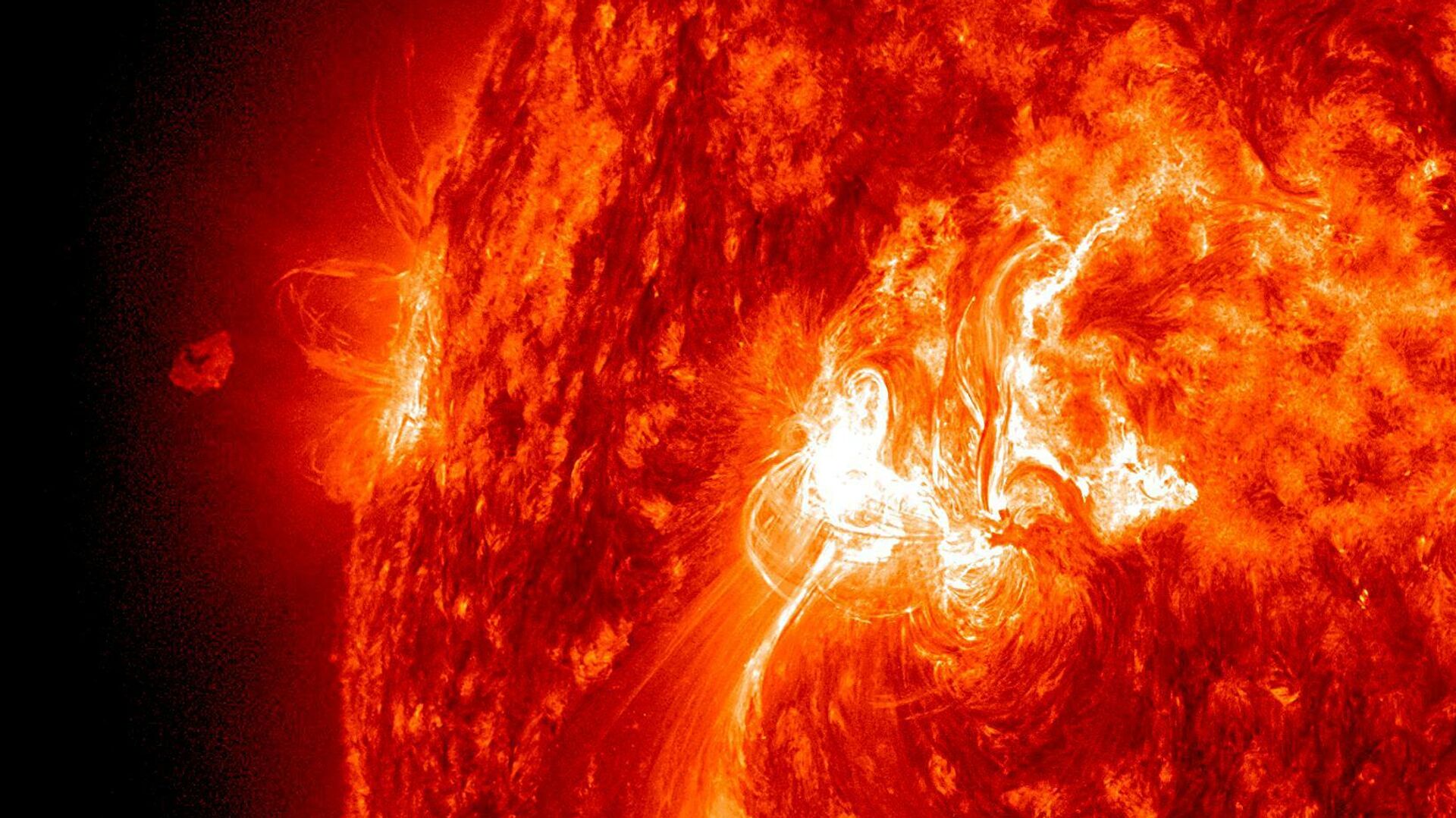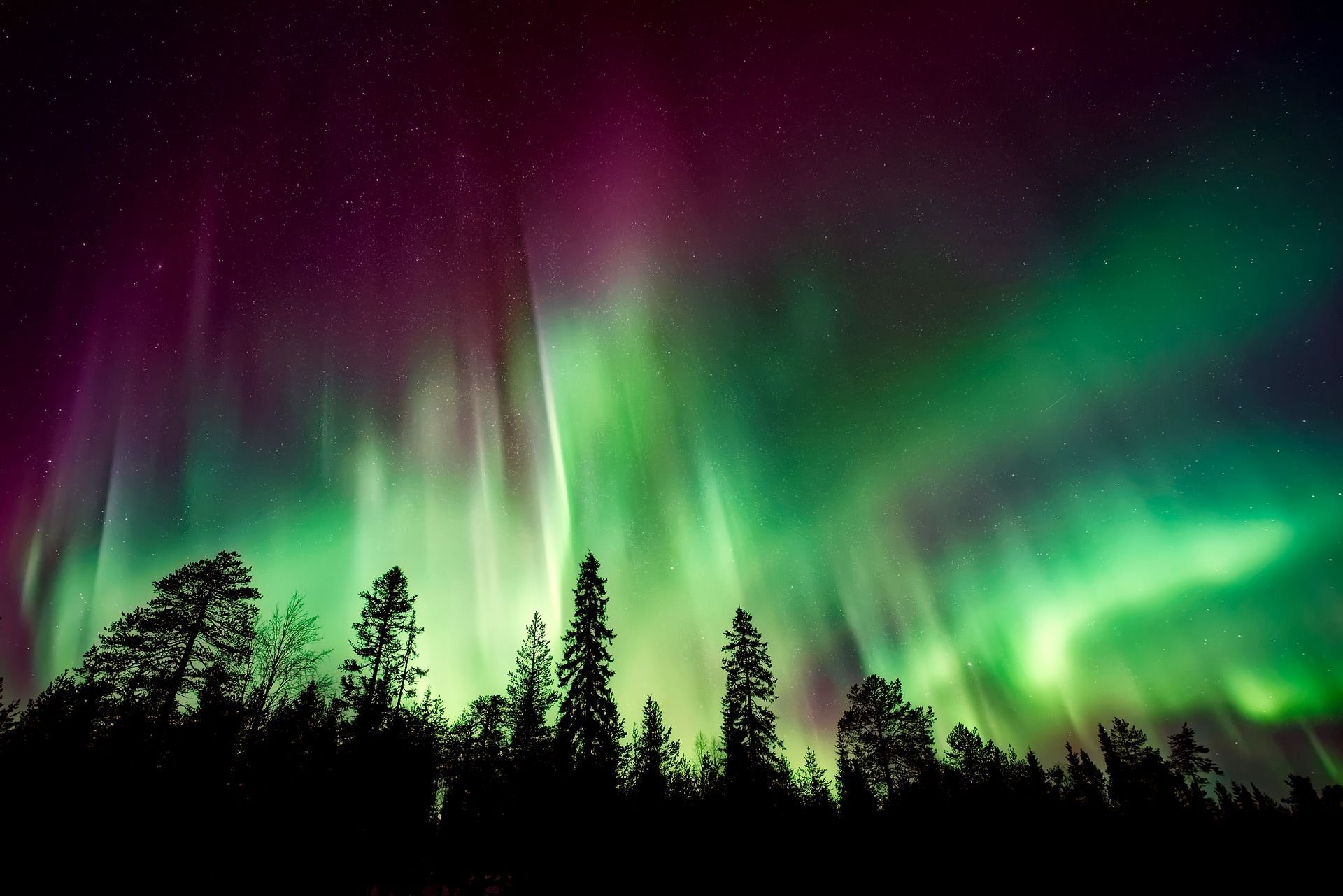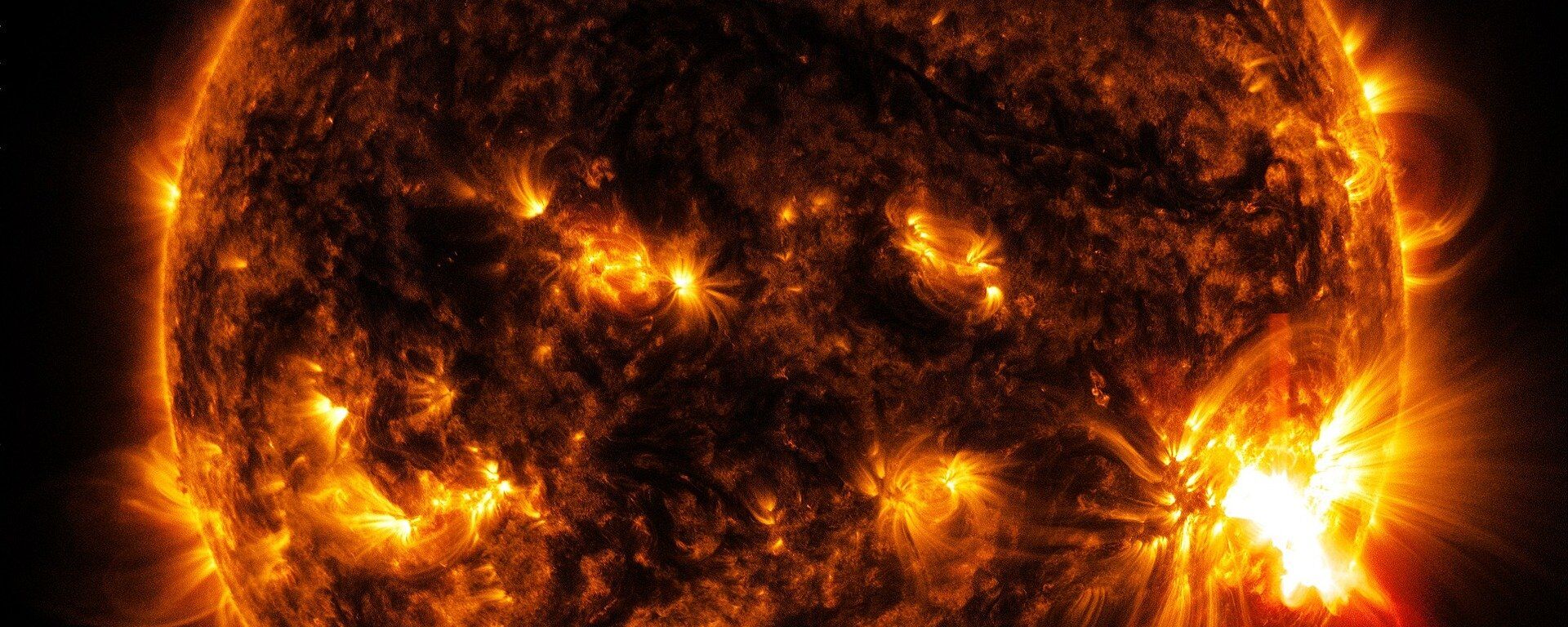https://sputnikglobe.com/20220407/canyon-of-fire-solar-wind-spitting-12000-mile-deep-chasm-opens-on-sun-1094549311.html
Canyon of Fire: Solar Wind-Spitting 12,000 Mile-Deep Chasm Opens on Sun
Canyon of Fire: Solar Wind-Spitting 12,000 Mile-Deep Chasm Opens on Sun
Sputnik International
Back in 2013, NASA shared a video of an eruption on the Sun that left a fissure of fire over 200,000 miles long across its surface. 07.04.2022, Sputnik International
2022-04-07T10:38+0000
2022-04-07T10:38+0000
2022-11-30T10:02+0000
solar winds
plasma
sun
https://cdn1.img.sputnikglobe.com/img/07e6/01/1d/1092597281_0:26:1650:954_1920x0_80_0_0_be1929e6807dbd6addc19a276253d7ef.jpg
A huge solar chasm – at least 12,400 miles (20,000 kilometres) deep and 10 times as long – opened on the surface of the Sun on 3 April, according to Space Weather.The massive fissure, which resulted in powerful streams of magnetised solar winds being unleashed, was discovered by NASA’s Solar Dynamics Observatory.Satellites in the extreme ultraviolet part of the electromagnetic spectrum as well as ground telescopes equipped to observe in the infrared wavelengths were able to zoom in on the eruptions. Two previous solar flares were reported over the weekend.The UK weather forecaster, the Met Office, confirmed the ejection of two “filament eruptions” from the canyon in the south-central part of the Sun and blasting out into space.The first erupted from the Sun on 3 April, at around 11 a.m. EDT (1500 GMT), while the second followed on 4 April at about 5 p.m. EDT (2100 GMT).Coronal mass ejections (CMEs) – expulsions of charged plasma from the Sun’s upper atmosphere (corona) – accompanied the eruptions, said the Met office.Coronal mass ejections, upon reaching Earth, generate geomagnetic storms, which, if powerful, can disrupt satellite links and damage electronics in orbit.Such processes also often bring with them auroras, or polar lights, with the Met suggesting that several might be observed in Earth’s sky, predominantly in high-latitude regions (around the Arctic and Antarctic) later this week.Earth's magnetic field is the weakest above the poles, with magnetised particles from CMEs penetrating deeper into Earth’s atmosphere in those regions.It is the interaction between the solar particles and those in the atmosphere that is responsible for the colourful displays.Despite the current intense solar winds linked to the fiery canyon, overall, solar activity is relatively subdued. According to the Met, the Sun has only begun to wake up from a prolonged solar minimum.The latter is a period of low solar activity in the Sun's 11-year solar cycle, during which sunspot and solar flare activity diminishes. Scientists anticipate solar activity to gather momentum over the coming years, peaking at around 2025.A video of an eruption on the Sun was shared by NASA in 2013, resulting in a fissure of fire over 200,000 miles long across its surface.
https://sputnikglobe.com/20220331/cannibal-coronal-mass-ejection-hits-earth-triggers-geomagnetic-storm--auroras-1094368266.html
Sputnik International
feedback@sputniknews.com
+74956456601
MIA „Rossiya Segodnya“
2022
News
en_EN
Sputnik International
feedback@sputniknews.com
+74956456601
MIA „Rossiya Segodnya“
Sputnik International
feedback@sputniknews.com
+74956456601
MIA „Rossiya Segodnya“
solar winds, plasma, sun
Canyon of Fire: Solar Wind-Spitting 12,000 Mile-Deep Chasm Opens on Sun
10:38 GMT 07.04.2022 (Updated: 10:02 GMT 30.11.2022) Back in 2013, NASA shared a video of an eruption on the Sun that left a fissure of fire over 200,000 miles long across its surface.
A huge solar chasm – at least 12,400 miles (20,000 kilometres) deep and 10 times as long – opened on the surface of the Sun on 3 April, according to
Space Weather.
The massive fissure, which resulted in powerful streams of magnetised solar winds being unleashed, was discovered by NASA’s Solar Dynamics Observatory.
Satellites in the extreme ultraviolet part of the electromagnetic spectrum as well as ground telescopes equipped to observe in the infrared wavelengths were able to zoom in on the eruptions. Two previous solar flares were reported over the weekend.
The UK weather forecaster, the Met Office, confirmed the ejection of two “filament eruptions” from the canyon in the south-central part of the Sun and blasting out into space.
The first erupted from the Sun on 3 April, at around 11 a.m. EDT (1500 GMT), while the second followed on 4 April at about 5 p.m. EDT (2100 GMT).
Coronal mass ejections (CMEs) – expulsions of charged plasma from the Sun’s upper atmosphere (corona) – accompanied the eruptions,
said the Met office.
Coronal mass ejections, upon reaching Earth, generate geomagnetic storms, which, if powerful, can disrupt satellite links and damage electronics in orbit.
Such processes also often bring with them
auroras, or polar lights, with the Met suggesting that several might be observed in Earth’s sky, predominantly in high-latitude regions (around the Arctic and Antarctic) later this week.
Earth's magnetic field is the weakest above the poles, with magnetised particles from CMEs penetrating deeper into Earth’s atmosphere in those regions.
It is the interaction between the solar particles and those in the atmosphere that is responsible for the colourful displays.
Despite the current intense solar winds linked to the fiery canyon, overall, solar activity is relatively subdued. According to the Met, the Sun has only begun to wake up from a prolonged solar minimum.
The latter is a period of low
solar activity in the Sun's 11-year solar cycle, during which sunspot and solar flare activity diminishes. Scientists anticipate solar activity to gather momentum over the coming years, peaking at around 2025.
A video of an eruption on the Sun
was shared by NASA in 2013, resulting in a fissure of fire over 200,000 miles long across its surface.





